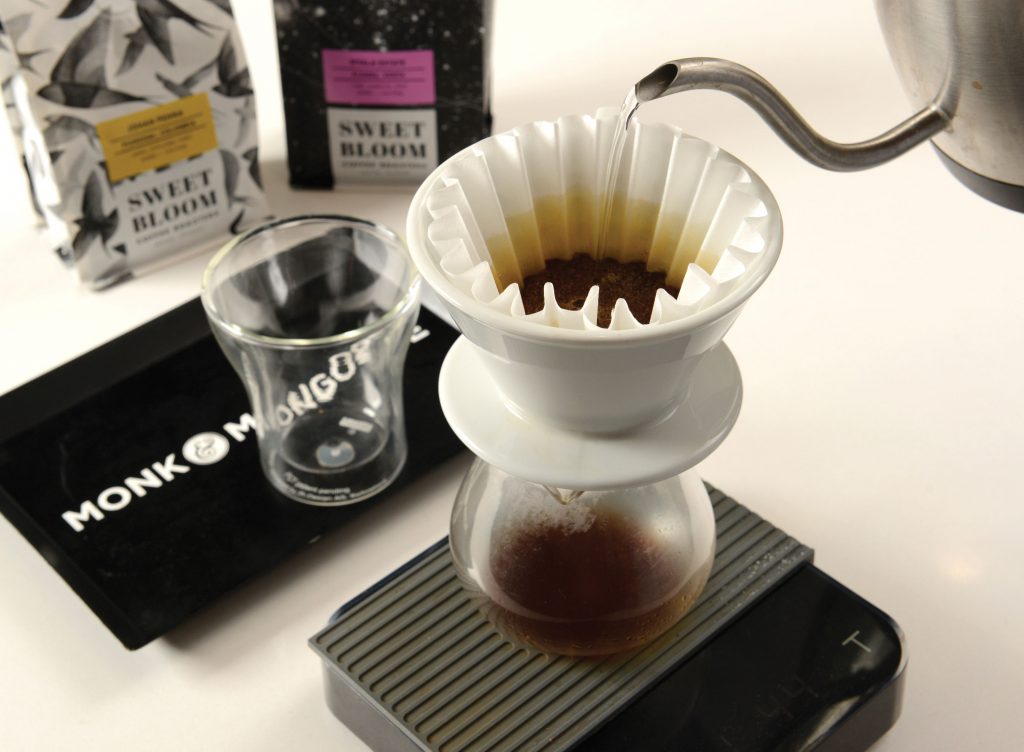Time for the home cup of classic black coffee to become an artisanal, richly flavored brew. These simple steps from Josiah Rothlisberger (pictured below), the director of education at Monk and Mongoose Gourmet Coffee in Lone Tree and Greenwood Village, will elevate the morning ritual. Excuse us, we’re suddenly in the mood for another cup.

BUY FRESH BEANS
The biggest mistake homebrewers make is selecting bad beans. “There is absolutely no amount of brewing equipment that can make a good cup of coffee out of bad coffee beans,” says Rothlisberger. Buy whole beans—from a boutique grocery store or even Whole Foods—that have been freshly roasted.
The best way to determine freshness is by the roast date. Rothlisberger doesn’t buy coffee beans that were roasted more than two weeks prior to his shopping date; anything more than a month old is no longer fresh.
GET TO GRINDING
Grinding beans enhances the flavor and experience. There are two types of grinders, a blade grinder and a burr grinder. “Burr grinders are the way to go,” Rothlisberger says. The serrated plates (called burrs) are precise, more consistent and will extract the most flavor.
Rothlisberger’s pick: the Baratza Encore burr grinder.
THINK ABOUT YOUR WATER
Rothlisberger’s rule of thumb when it comes to H2O: “If you don’t like the flavor of your tap water, you’re probably not going to like the flavor of that water in your coffee.” A basic water purifier can help make a cleaner cup of joe. Heating your water to an ideal temperature, too, will get the best flavor. “The optimal temperature is 200 degrees Fahrenheit,” he says.
Rothlisberger’s pick: the Brewista Smart Pour Variable Temperature Gooseneck Kettle, which automatically heats water to a manually selected temperature.
EXPERIMENT WITH POUR-OVERS
“There are all kinds of neat pour-over methods and equipment to try,” says Rothlisberger. Each emphasize specific flavors in your grounds.
To bring out volatile, acidic notes, try a French press. For no acidic notes, try an AeroPress. For something even lighter, use a Chemex coffee maker. For a bold brew with more body, the Hario V60 ceramic coffee dripper (size 02) should be your go-to.
Regardless of method, there are four components to master in pour-overs to yield the most flavor: 1. grind quality; 2. water temperature; 3. the water to coffee ratio; and 4. the amount of time you’re brewing—too much and your coffee will be bitter, too little and it will be acidic and sour.
Rothlisberger’s pick: The Brewtime app (available on Apple and Android) will tell you the right “recipe” and ratio for each method.
INVEST IN A SCALE
A scale for weighing beans is essential because it helps control your ratio, says Rothlisberger: “I prefer 1 gram of water to 17 ½ grams of coffee, which is a safe general ratio.”
Rothlisberger’s picks: the Brewista Smart Scale and the Hario V60 Drip Scale, which Rothlisberger has on his own kitchen counter.
GO TO THE PROS
Monk and Mongoose Gourmet Coffee
Lone Tree: 720.638.8844
Greenwood Village: 720.456.7623


